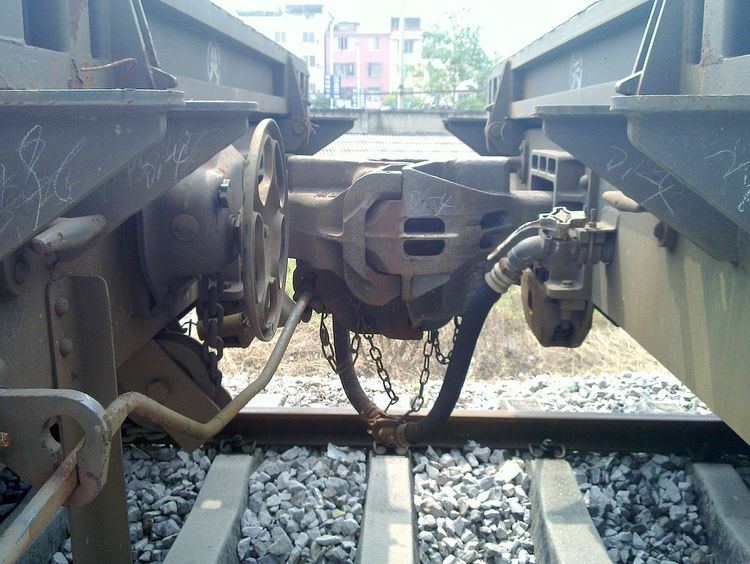 | ||
The AAR/APTA TypeH TightLock coupler is a Janney automatic coupler typically used on North American mainline passenger cars. TypeH couplers have mechanical features to reduce slack action and improve safety, but remains compatible with Janney/AAR TypeE and TypeF couplers. TypeH couplers may also be fitted with automatic air and electrical connections. Management and development of TypeH coupler standards have been transferred from the AAR to American Public Transportation Association (APTA). The AAR/APTA standard mounting height for TypeH couplers is 34.5 inches (876.3 mm) ATOR.
Rail operators that commonly use TypeH couplers include Amtrak, Agence métropolitaine de transport, GO Transit, Via Rail and West Coast Express. TypeH couplers have also seen very limited use on British Railways electric multiple units (EMUs) such as the Bombardier "Electrostar", though recently, Dellner or Scharfenberg couplers are being used instead.
The AAR TypeF TightLock coupler is a Janney automatic coupler typically used on North American gondola cars that go through rotary car dumpers as well as on some tank cars. Tank cars carrying hazardous materials are equipped with AAR TypeE double shelf couplers.
Tightlock use in the United Kingdom
Type H couplers are in widespread use on multiple unit passenger trains in the UK built from the mid 1970s onwards. The previous generation of slam door units fitted with Buckeye couplers had required a shunter to get down onto the track and stand between the two units to manually trip the coupler mechanism as well as connect or disconnect the air pipes and electrical jumper leads. In order to reduce staffing costs and cut down station dwell times, British Rail looked to incorporate an automatic coupler mechanism in its new power-door trains. Class 313 units were the first stock to incorporate this. Air-operated Tightlock couplers were chosen, together with underslung electrical connector boxes controlled by a Drum switch, and this allowed drivers to single-handedly attach or split a train without having to leave the cab.
Classes of train equipped included:
The Tightlocks were generally a success, but there were reliability issues and some notable incidents occurred where trains divided in service. The constant couple-uncouple cycles of heavy London commuter services caused the couplers' mechanisms to wear out faster than expected. Connex South Eastern's Networker fleet was particularly susceptible to this and the company loudly blamed its drivers in the media, then changed its coupling instructions to drivers to include a "Push-on, pull off" power test and visual inspection to ensure that the knuckles had engaged fully.
By the 1990s the first batch of Bombardier "Electrostar" Class 375 had been built with tightlock couplers for First Capital Connect, Southern and Southeastern, but it was quickly decided that Dellner couplings would be preferable. All subsequent units were built with these, and their earlier examples were eventually modified.
All multiple unit trains built for the UK since then have been equipped with Dellner couplings.
